My new Arms and Armor claymore showed up today. (Thanks Joe!) WOW! It's a big beast isn't it? My wife tells me it's going to have to go live in the shop with the pole axe since it doesn't fit in the safe... A full review will of course be forthcoming. A quick question for you Scots types out there. What are the purpose of the "langets" (forl lack of a better term) that extend through the cross on each side of the blade? I always thought they were attached to the blade but these don't seem to be... what gives?
Russ;
Until someone replies with some real information here are some possible uses;
1) Non-use answers: Decorative, tradition and nobody knows why. :p
2) Trapping and opponents' blade for a disarm or breakage?
3) help keep the sword in its' scabbard securely ?
4) Each side could be used as a belt hook at waist level or maybe on an over the shoulder carry on some sort of baldric with a hole at shoulder level: This might work over the shoulder because unhooking it would mean moving the sword up only a few inches as opposed to the usually impractical shoulder scabbard idea ! At least when reasonably quick use is concerned as opposed to simple carry. ( This is based on absolutely nothing but my imagination and a close examination of the languettes ( French spelling ) might prove it wrong. as not even possible ??? )
Until someone replies with some real information here are some possible uses;
1) Non-use answers: Decorative, tradition and nobody knows why. :p
2) Trapping and opponents' blade for a disarm or breakage?
3) help keep the sword in its' scabbard securely ?
4) Each side could be used as a belt hook at waist level or maybe on an over the shoulder carry on some sort of baldric with a hole at shoulder level: This might work over the shoulder because unhooking it would mean moving the sword up only a few inches as opposed to the usually impractical shoulder scabbard idea ! At least when reasonably quick use is concerned as opposed to simple carry. ( This is based on absolutely nothing but my imagination and a close examination of the languettes ( French spelling ) might prove it wrong. as not even possible ??? )
Hmmm interesting ideas, I would discount the belt hook one, no one is carrying this at their waist . The sword is HUGE, not as big as one of the German Zwiehanders but still very large. I can't discount the other ideas though...
Look at Paul Dolnsteiners drawing of the Swedish soldier in this tread... http://www.myArmoury.com/talk/viewtopic.php?t=4668
That is a big sword carried at th waist.... the hooks dont hav to be single or could be more like rings...
Just my two c...
Martin
That is a big sword carried at th waist.... the hooks dont hav to be single or could be more like rings...
Just my two c...
Martin
Hi Russ
I'm of the opinion that the langet feature was originally designed to help give the hilt a bit of extra sturdiness against the give of such a long flexible blade ! Not that it would provide much, but it probably does slightly help the hilts stability & balence !
The langets are gapped, from the blade, but not always by alot !
I've always questioned the idea that they were for scabbard retention, ? , but I suppose if they worked for that why not !
Just my 2 cents of guesswork ;-) Mac
* Original claymore's at the Museum of Scotland, Edinburgh.
- Color photos: Thomas McDonald, 2004, B&W: from John Wallace 'Scottish Swords & Dirks', 1970.
Photos : (1.) - LA 105, (2.) LA 89, (3.) LA 105, (4.) LA 89, (5). LA 105
 Attachment: 44.17 KB
Attachment: 44.17 KB
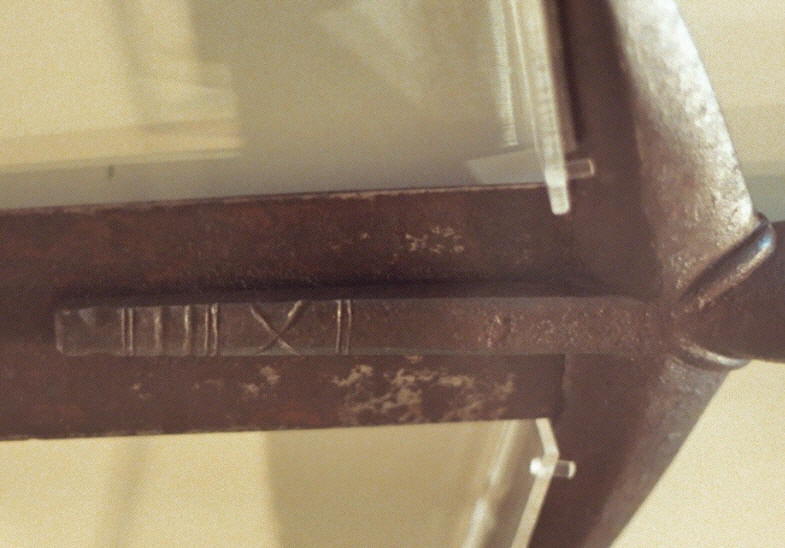
 Attachment: 52.44 KB
Attachment: 52.44 KB
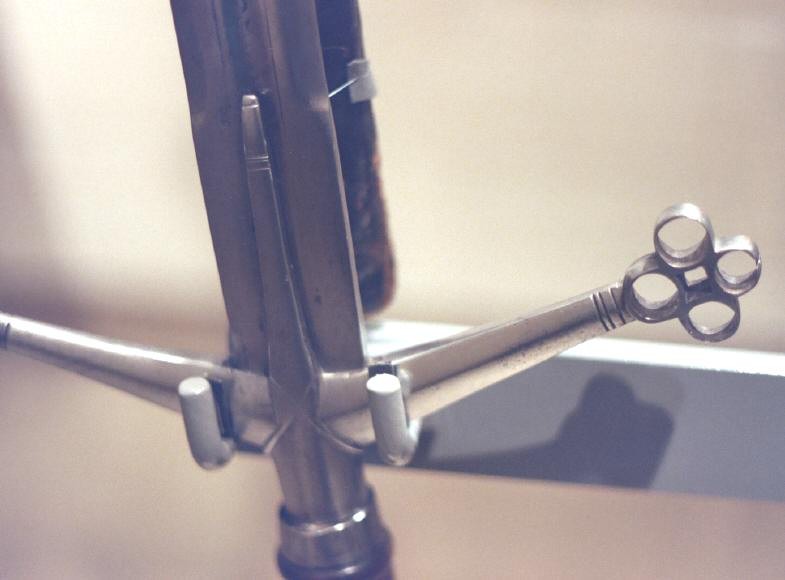
 Attachment: 48.51 KB
Attachment: 48.51 KB
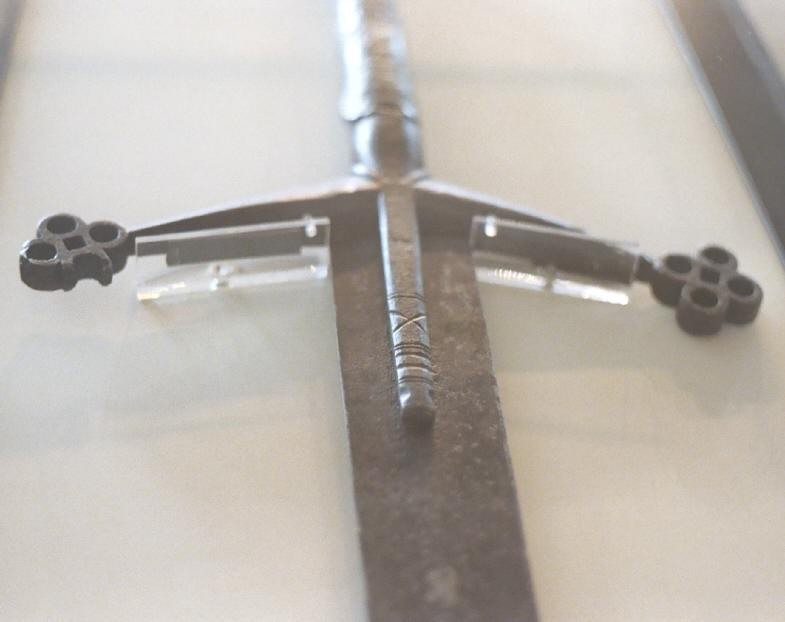
 Attachment: 41.04 KB
Attachment: 41.04 KB
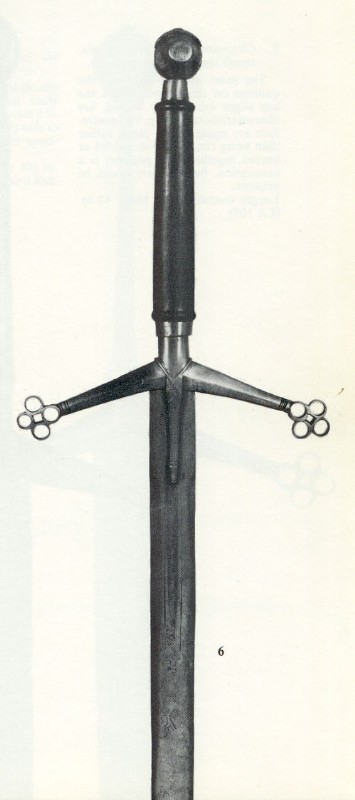
 Attachment: 44.37 KB
Attachment: 44.37 KB
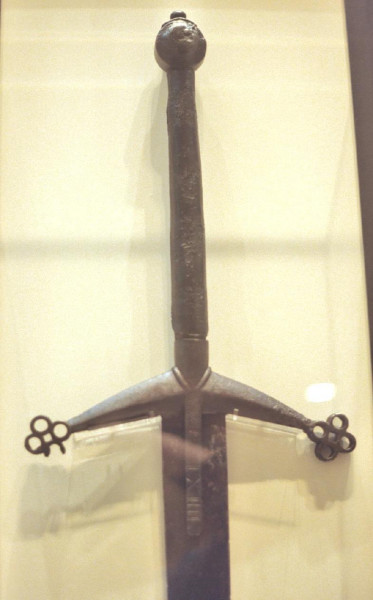
I'm of the opinion that the langet feature was originally designed to help give the hilt a bit of extra sturdiness against the give of such a long flexible blade ! Not that it would provide much, but it probably does slightly help the hilts stability & balence !
The langets are gapped, from the blade, but not always by alot !
I've always questioned the idea that they were for scabbard retention, ? , but I suppose if they worked for that why not !
Just my 2 cents of guesswork ;-) Mac
* Original claymore's at the Museum of Scotland, Edinburgh.
- Color photos: Thomas McDonald, 2004, B&W: from John Wallace 'Scottish Swords & Dirks', 1970.
Photos : (1.) - LA 105, (2.) LA 89, (3.) LA 105, (4.) LA 89, (5). LA 105





Last edited by Thomas McDonald on Thu 08 Sep, 2005 5:34 pm; edited 1 time in total
| Thomas McDonald wrote: |
| Hi Russ
I'm of the opinion that the langet feature was originally designed to help give the hilt a bit of extra sturdiness against the give of such a long flexible blade ! Not that it would provide much, but it probably does slightly help the hilts stability & balence ! The langets are gapped, from the blade, but not always by alot ! I've always questioned the idea that they were for scabbard retention, ? , but I suppose if they worked for that why not ! Just my 2 cents of guesswork ;-) Mac * Original claymore's at the Museum of Scotland, Edinburgh. Photos by Mac |
Not trying to be a pain Mac, and it's sort of plausible, but why not affix them directly to the blade if that was the case...??? So in all the examples you have seen they are always gapped?
Maybe it's just style. Like the quatrefoils.
| Russ Ellis wrote: | ||
Not trying to be a pain Mac, and it's sort of plausible, but why not affix them directly to the blade if that was the case...??? So in all the examples you have seen they are always gapped? |
Hi Russ
No problemo ..... the more we question the more we come (hopefully ;-) to a consensus .....
To answer your question ..... I dunno ?
Perhaps they are are designed that way so as not to interfere with the blades harmonics, but to provide a certain amount of hilt stability during some wild cleaving cut ? They certainly are not there in an attempt to support the blade !
Of the originals I've viewed up close, they all seemed to have a slight gap (a few to the point that they almost look to be touching) !
Maybe they're nothing more than some decorative phallic symbol of Scottish manhood ;-) Mac
You're welcome, Russ!
Always did scare the neighbors when I'd take it out to the backyard... :D
Always did scare the neighbors when I'd take it out to the backyard... :D
I'm no expert on the claymores, but I'll toss in my 2cents as well.
From what I could find and see most of the langets didn't extend much beyond a few inches down the length of the blade. So say 3" of coverage on a blade that is 42" means that roughly 1/14 or about 7% of the blade is reinforced. Doesn't seem like a whole heck of a lot.
Then I tried looking at the hilt and langet as an entire system since they are attached to one another, with the tang of the blade passing through. Now I'm looking at an overall sword of lets say 55" for arguments sake, with 13" or so the hilt. Add another 3" for the langet and I'm up to 16" out of 55" or about 29%. Definately a marked jump up.
I tried to compare it to holding something of a decent length with some flexibility. A piece of PVC pipe of small diameter that can flex when swung. the farther up your grip is the less flex you get out of the remaining pipe. I think the key is to look at the langet as an extension of the guard which in turn, when butted to the hilt and then secured by the pommel all become one system when forces are applied.
I'm pretty much rehashing what Mac has already stated, so I'm certainly not taking any credit for that. I was just trying to apply a little math and science so I could get a better understanding. Again it could all just be in my head as the saying goes :)
As for the gap between the blade and langet I can only offer this. As Mac stated some of these appear to be so close as to be touching. Could it be that this design was intentional? I have to agree with Mac that contact could affect harmonics. But also if I recall anything that is too rigid is prone to breaking. Could the gaps have served as some sort of early expansion joint? Allowing the blade some room for travel, but not so much as to override the purpose of the langet.
From what I could find and see most of the langets didn't extend much beyond a few inches down the length of the blade. So say 3" of coverage on a blade that is 42" means that roughly 1/14 or about 7% of the blade is reinforced. Doesn't seem like a whole heck of a lot.
Then I tried looking at the hilt and langet as an entire system since they are attached to one another, with the tang of the blade passing through. Now I'm looking at an overall sword of lets say 55" for arguments sake, with 13" or so the hilt. Add another 3" for the langet and I'm up to 16" out of 55" or about 29%. Definately a marked jump up.
I tried to compare it to holding something of a decent length with some flexibility. A piece of PVC pipe of small diameter that can flex when swung. the farther up your grip is the less flex you get out of the remaining pipe. I think the key is to look at the langet as an extension of the guard which in turn, when butted to the hilt and then secured by the pommel all become one system when forces are applied.
I'm pretty much rehashing what Mac has already stated, so I'm certainly not taking any credit for that. I was just trying to apply a little math and science so I could get a better understanding. Again it could all just be in my head as the saying goes :)
As for the gap between the blade and langet I can only offer this. As Mac stated some of these appear to be so close as to be touching. Could it be that this design was intentional? I have to agree with Mac that contact could affect harmonics. But also if I recall anything that is too rigid is prone to breaking. Could the gaps have served as some sort of early expansion joint? Allowing the blade some room for travel, but not so much as to override the purpose of the langet.
Mac
 Attachment: 31.96 KB
Attachment: 31.96 KB
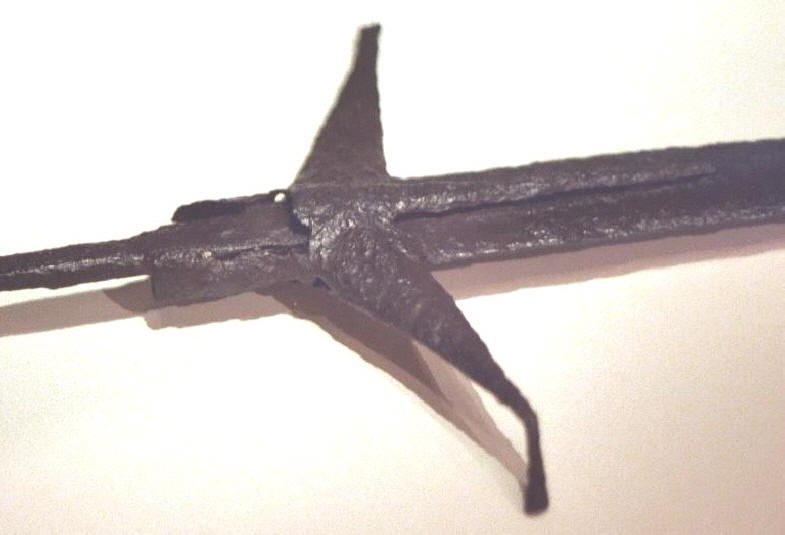

Here's a shot I took of one of my old A&A claymore's showing the langet to blade gap !
Is yours about the same, Russ ? Thanks, Mac
Is yours about the same, Russ ? Thanks, Mac
Yep, that's pretty much spot on for the one I've got. I was rather surprised to see that large gap to say the least. Do you have another claymore these days Mac?
| Russ Ellis wrote: |
| Yep, that's pretty much spot on for the one I've got. I was rather surprised to see that large gap to say the least. Do you have another claymore these days Mac? |
Hi Russ
I've got these three claidheamh mor by Vince Evans !
Mac
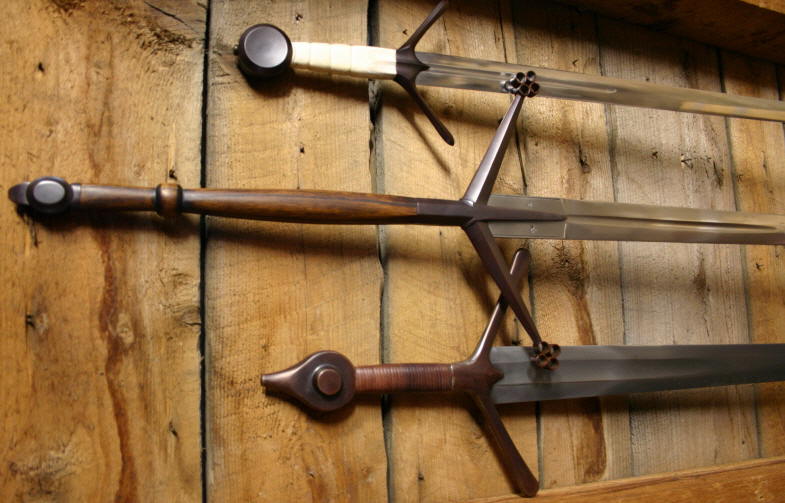
Oh my... um well um... I can see why you might not exactly be pining for your old Arms and Armor claymore... Beautiful stuff you have there Mac.
In fact, you can see the evolutionary heritage of the two-hand Claymore in Mac's (oooooh, ahhhhhh, drooool) nice picture just posted. You can see the short langets of the Medieval Highland single and hand-and-a-half swords, which eventually developed into the longer langets on the longer swords (also you can notice the downturned quillons, which are evident on the older swords. But how those globular terminals turned into the quatrefoils, though... I couldn't tell you...).
:!: disclaimer :!:
I'm probably gonna make a fool of my self here, but I'm used to it so here goes. I futher aknowledge that I know little or nothing of Scottish military history, which is doubly sad because I'm a descendant of James Buchanan, and yes I saw braveheart which was an abomination to history and I realize that his claymore was farcical.
I have a LOWend (read $50) claymore I got off of ebay primarily as a wallhanger. I tried various grips with it and found that grabbing the ricasso is rather inpleasant. I can only imagine that not every highlander had gloves, but wrapping cloth or leather around the ricasso would be
A) cheap.
B) more comfortable
C) a perishable medium which would not be on any original peices.
D) more comfortable.
E) possibly an explanation for the gap.
I'm sure I'm wrong but it SOUNDS good right?
I'm probably gonna make a fool of my self here, but I'm used to it so here goes. I futher aknowledge that I know little or nothing of Scottish military history, which is doubly sad because I'm a descendant of James Buchanan, and yes I saw braveheart which was an abomination to history and I realize that his claymore was farcical.
I have a LOWend (read $50) claymore I got off of ebay primarily as a wallhanger. I tried various grips with it and found that grabbing the ricasso is rather inpleasant. I can only imagine that not every highlander had gloves, but wrapping cloth or leather around the ricasso would be
A) cheap.
B) more comfortable
C) a perishable medium which would not be on any original peices.
D) more comfortable.
E) possibly an explanation for the gap.
I'm sure I'm wrong but it SOUNDS good right?
| Gavin Kisebach wrote: |
| :!: disclaimer :!:
I'm probably gonna make a fool of my self here, but I'm used to it so here goes. I futher aknowledge that I know little or nothing of Scottish military history, which is doubly sad because I'm a descendant of James Buchanan, and yes I saw braveheart which was an abomination to history and I realize that his claymore was farcical. I have a LOWend (read $50) claymore I got off of ebay primarily as a wallhanger. I tried various grips with it and found that grabbing the ricasso is rather inpleasant. I can only imagine that not every highlander had gloves, but wrapping cloth or leather around the ricasso would be A) cheap. B) more comfortable C) a perishable medium which would not be on any original peices. D) more comfortable. E) possibly an explanation for the gap. I'm sure I'm wrong but it SOUNDS good right? |
Hmm now there's an interesting thought. I don't think I for one am prepared to tell you that you are incorrect. You may be exactly right for all I know. :)
do you think wrapping a bit of the clan tartan around the riccasso would eat any vibration? or am I being silly now?
Perhaps a little bit ;) The idea of wrapping some kind of cloth or leather (though I've never heard of any such source) around the ricasso may be possible- but you arent going to be seeing a whole lot of tartan before 1600. (there is evidence of earlier tartan, I'm just rounding off) And there isn't going to be any specific 'Clan' tartans untill well into the end of the 18th and into the 19th century, if I understand it right. The CDL was well out of favor by the 1600's. I know alot of modern art depicts a tartan wrapped ricasso or pommel and the ending images of Braveheart certainly are romantic- but I think it's starting to border closer on the edge of fantasy there.
And besides, there are plenty of long and great swords from the continent (not to mention the Scottish lowland greatswords), that feature no such gap and don't seem to suffer from adverse affects of blade vibration from a lack of some sort of wrapping. In fact, the only real example of this that I'm aware of is the German doppelhanders and it seems pretty apparent it was used specifically as a secondary gripping surface. The Scottish CDL's feature no forward 'spikes' to help protect the hand like the German swords have. (What is the correct term for those things anyway?)
And besides, there are plenty of long and great swords from the continent (not to mention the Scottish lowland greatswords), that feature no such gap and don't seem to suffer from adverse affects of blade vibration from a lack of some sort of wrapping. In fact, the only real example of this that I'm aware of is the German doppelhanders and it seems pretty apparent it was used specifically as a secondary gripping surface. The Scottish CDL's feature no forward 'spikes' to help protect the hand like the German swords have. (What is the correct term for those things anyway?)
Page 1 of 6
You cannot post new topics in this forumYou cannot reply to topics in this forum
You cannot edit your posts in this forum
You cannot delete your posts in this forum
You cannot vote in polls in this forum
You cannot attach files in this forum
You can download files in this forum
All contents © Copyright 2003-2006 myArmoury.com — All rights reserved
Discussion forums powered by phpBB © The phpBB Group
Switch to the Full-featured Version of the forum
Discussion forums powered by phpBB © The phpBB Group
Switch to the Full-featured Version of the forum